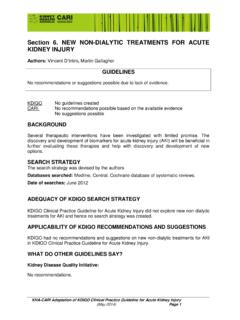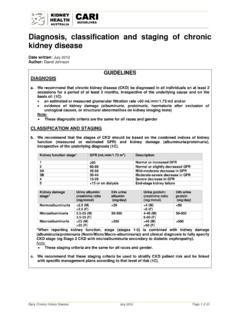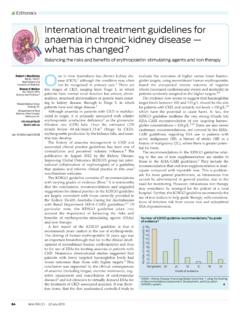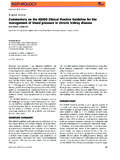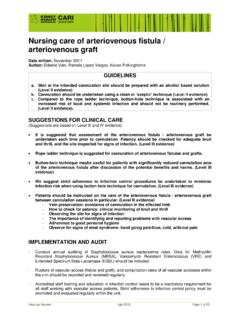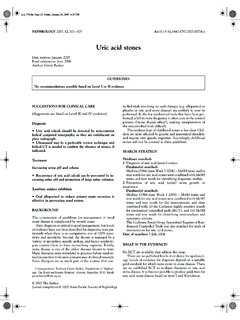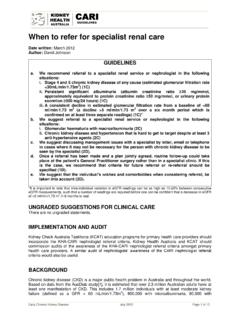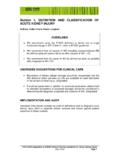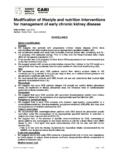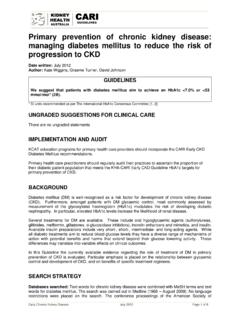Transcription of Duration and frequency of haemodialysis therapy
1 The CARI Guidelines Caring for Australians with Renal Impairment dialysis Adequacy haemodialysis (July 2005) Duration and frequency of haemodialysis therapy Date written: December 2004 Final submission: December 2004 GUIDELINES No recommendations possible based on Level I or II evidence SUGGESTIONS FOR CLINICAL CARE (Suggestions are based on Level III and IV evidence) The advantages of prolonged and more frequent dialysis should be discussed in depth with patients approaching dialysis , and the advantages of home haemodialysis should be presented in detail. While 6 8 hours each night, five or six nights weekly, might be optimal therapy , it may be difficult to persuade patients to accept more than (for example) 7 hours each night on alternate nights.
2 Even this would be an improvement on current regimens. Short daily dialysis is also an option. While extending hours and increasing dialysis frequency would be difficult in dialysis centres, it could perhaps be tried in selected patients. Background A major randomised controlled trial (RCT) into dialysis has recently been completed the HEMO study (Eknoyan et al 2002). A standard urea reduction ratio (URR) of 65% was compared with an increased dose of dialysis , a URR of 75%. Intuitively, one would expect that an increased dose of dialysis would lead to an improvement in survival. This however, was not the case in the HEMO study (Cheung et al 2003; Allon et al 2003).
3 There was also no improvement in outcome when high-flux membranes were compared with low-flux membranes. In this study, the annual mortality rate for all treatment groups was 17%. Similar mortality rates are reported from registries such as ANZDATA (Kerr 2002). The mortality rate of patients on dialysis is markedly higher than the mortality rate following renal transplantation, which is about 3% per annum (McDonald & Russ 2002). Short, thrice-weekly dialysis appears to give unsatisfactory outcomes and it does not seem to be possible to improve these outcomes in the context of three dialyses weekly, each session lasting for 4 hours or less.
4 It might be possible to improve both the quality and Duration of life in dialysis patients by increasing the Duration of dialysis , the frequency of dialysis , or both. OUT OF DATEThe CARI Guidelines Caring for Australians with Renal Impairment dialysis Adequacy haemodialysis (July 2005) Search strategy Databases searched: MeSH terms and text words for dialysis were combined with MeSH terms and text words for short daily, nocturnal, frequency and Duration , and then combined with the Cochrane highly sensitive search strategy for randomised controlled trials. The search was carried out in Medline (1966 February Week 1 2004).
5 The Cochrane Renal Group Trials Register was also searched for trials not indexed in Medline. Date of searches: 18 February 2004. What is the evidence? In the National Cooperative dialysis Study (NCDS), performed over 20 years ago, four groups were examined (Lowrie et al 1981). One group had high average urea concentration and short dialysis Duration . A second group had a high average urea concentration and long dialysis Duration . A third group had a low average urea and short dialysis Duration . A fourth group had a low average urea and long dialysis Duration . Patients who received a high dose of dialysis and ran low average urea concentrations fared better than patients who had a lower dialysis dose and ran higher average urea levels.
6 In addition, patients who were dialysed for longer did better than patients whose dialysis Duration was shorter. This difference did not quite reach statistical significance, as the p value was The NCDS study suggested that dialysis Duration was important but failed to prove this. It is possible that statistical significance would have been reached if more patients had been included (n = 151). The attitude of the dialysis community, however, has been that the NCDS study proved that dialysis Duration was unimportant. Apart from the NCDS study, there have been no RCTs investigating the question of dialysis Duration .
7 There are only observational studies. The best survival results for thrice-weekly haemodialysis are those reported by Charra et al (1992). A 10-year patient survival of 75% was achieved. dialysis used Kiil plates for three 8-hour sessions weekly. A total of 445 patients were studied. These patients had solute clearances which were substantially better than those achieved with thrice-weekly short dialysis . In addition, the Duration of the dialyses allowed excellent control of fluid and blood pressure. Registry studies, both in the US (Held et al 1991) and in Australia (Kerr 2002), have shown an increase in patient survival with an increase in dialysis Duration .
8 The 2002 ANZDATA report showed a 5-year survival of 60% for 1615 patients dialysing for between 15 and hours each week, compared with a 5-year survival of 40% for 1257 patients dialysing for less than 12 hours each week. This difference was statistically significant (p < ). Increasing the frequency of dialysis can also be of benefit. In one study, patients were changed from thrice-weekly to 6 times-weekly dialysis ; 72 patients were involved (Woods et al 1999). Total weekly dialysis hours were reduced from an OUT OF DATEThe CARI Guidelines Caring for Australians with Renal Impairment dialysis Adequacy haemodialysis (July 2005) average of 12 hours each week to 10 hours per week.
9 Blood pressure control improved and patient survival at two years was 100%. Similar results were obtained in a smaller study in the Netherlands (Kooistra 2003). Similarly, blood pressure control and quality of life improved with more frequent, shorter dialysis . Patients acted as their own controls, and total weekly Kt/V was kept constant. Blood pressure control and quality of life both improved.. Another approach to reducing urea is by nocturnal haemodialysis , where both the Duration and frequency of dialysis are increased. This technique was pioneered in Canada, but is now practiced widely in other centres, including Australia and the Netherlands (Lindsay 2004; Pierratos 2004; Lockridge et al 2004; Agar et al 2003; Kooistra 2003; Kooistra et al 1998).
10 In a cohort of 83 patients, patient survival was 81% over 5 years (Pierratos 2004). Compared with short thrice-weekly dialysis , nocturnal dialysis is associated with improved salt and water control, increased solute removal, improved calcium and phosphate control, and a marked improvement in quality of life. Home haemodialysis is associated with improved survival compared with centre dialysis . Of course home patients tend to be younger and fitter than centre patients. Nevertheless, the odds ratio for death on home dialysis is in the US, rising to after adjusting for age and co-morbidities (Woods et al 1996). While a major increase in dialysis Duration and frequency could be difficult and expensive in centre dialysis , the home environment is ideal for short daily and long nocturnal haemodialysis .
